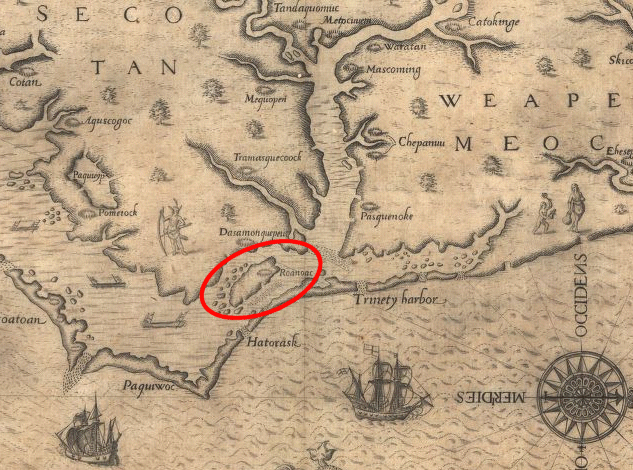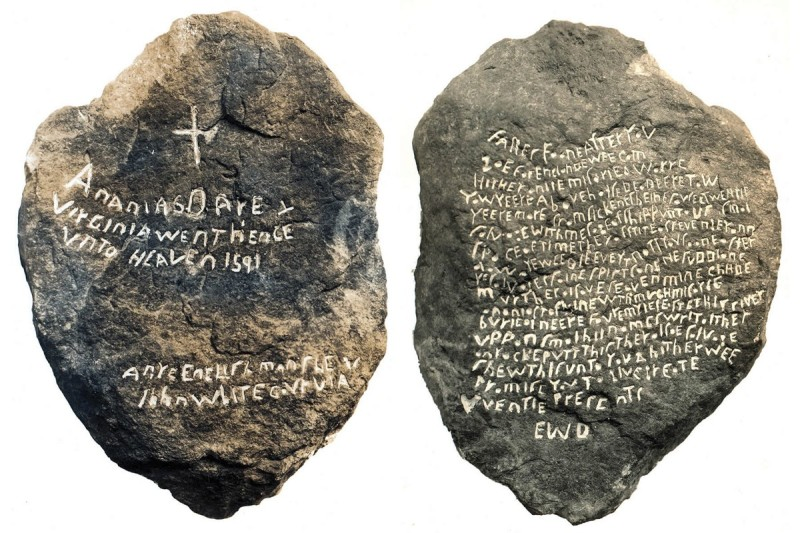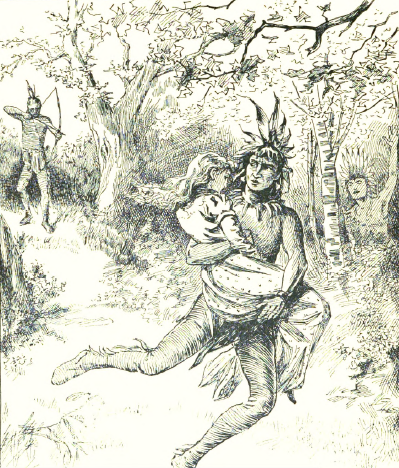
location of Roanoke Colony on White-De Bry Map of Virginia,
from Thomas Hariot's A briefe and true report of the new found land of Virginia (1590) (note that "west" rather than "north" is at the top of the map)
Source: Library of Congress

location of Roanoke Colony on White-De Bry Map of Virginia,
from Thomas Hariot's A briefe and true report of the new found land of Virginia (1590)
(note that "west" rather than "north" is at the top of the map)
Source: Library of Congress
The first English child known to have been born in North America was named Virginia Dare. She was born on August 18, 1587 at the colony on Roanoke Island. That island was in "Virginia" then, but is in the state of North Carolina now.
Virginia Dare was the daughter of Ananias Dare and his wife Ellinor (also spelled Eleanor and Elyonor). She was the daughter of the leader of the Roanoke colony, John White.1
Virginia Dare is also the first English child known to have died in Virginia. She was part of the "Lost Colony," last seen in 1587. Her mother, Eleanor White Dare, may have moved inland and carved a record of her daughter's death into a stone.
A stone discovered in 1937 was claimed to be a relict of the Lost Colony, but is most likely a fraud. The artifact includes an inscription stating that all but seven of the colonists had been slain by the Native Americans. According to the carved words, Virginia Dare and her father Ananias were among the victims but Eleanor White Dare initially survived:2

this stone, reportedly discovered in 1937, could indicate what happened to Virginia Dare
Source: Brenau University, The Dare Stones
Virginia Laydon, born in 1609, was the first English child known to have been born within the current boundaries of the state of Virginia. She was the daughter of John Laydon and Anne Burras. Anne Burras was the maidservant to Mistress Forrest, and together they were the first two women to arrive at Jamestown. Anne Burras married John Layden in December, 1608, shortly after her arrival.3
In contrast to the mix of colonists sent to Roanoke Island, no women had been included in the first expedition sent by the Virginia (London) Company to establish Jamestown. Men were perceived as the most capable colonists because they could explore, seeking mines or new pathways to China.
Women were not recognized as essential members of the colony until late in the company's management of Virginia. The decision to send women to Virginia in 1619 occurred when the Virginia Company consciously sought to make Virginia a more attractive colony for long-term settlement. Sending prospective wives to Jamestown, and granting more autonomy (including a popularly-elected legislature) to the colonists, was part of the new management strategy of the investors in the Virginia Company.
The very first child in Virginia with an English parent could have been born long before Virginia Dare on Roanoke Island in 1587. An English sailor working on one of the many Spanish ships that sailed along the coast in the 1500's could have had a child with a Native American woman. English sailors along the Atlantic Ocean coastline were rare before 1584, but there is no reason to assume that the sailors were celibate.
Similarly, the first child of a French parent may have been fathered by a sailor visiting the coastline, or traveling up the St. Lawrence River in the 1500's.
French settlers were willing than the English to have children with Native Americans. In New France along the St. Lawrence River, the absence of women immigrants from France led to liaisons. The mixed-race children became known as Metis. Their ability to navigate between the cultures of First Nation mothers and European fathers was key to the success of French traders who traveled deep into the interior of Canada and the Mississippi River valley. The first documented child of French parents may be Helene Desportes, born sometime after her parents Pierre Desportes and Francoise Langlois reached Quebec in 1614.4
In the first decades of English settlement in Virginia, there were far more male than female colonists. Sexual relationships between English men and Native American women must have occurred, but documentation is thin. Formal marriage between English colonists and Native Americans was not part of the Virginia Company's policy, with one famous exception.
The most notable interracial marriage was John Rolfe and Pocahontas in 1614. While sexual relations between the colonists and the Algonquians may have occurred often outside of marriage, and the English permitted the Indians to enter the colonial houses freely until the uprising in 1622, formal acceptance of Native Americans into colonial Virginia society was extremely rare. A "population pyramid" displaying age and gender for the early colony would not resemble the culture in England, and the absence of women may explain why some colonists returned to England as soon as they had a chance.
The gender imbalance of the colony indicates that the investors who financed colonization of Virginia did not intend to establish an agricultural community initially. Jamestown was planned to be an outpost of male workers, seeking minerals and secretly raiding Spanish ships. Until the recognition that farming was the path to wealth in Virginia, the London Company did not try to create a parallel society to England on the other side of the Atlantic Ocean.
The Virginia Company understood the potential role of women in a colonial settlement, but decided in 1606 to send just men to Jamestown on the Susan Constant, Godspeed, and Discovery. Of approximately 120 colonists who arrived at Roanoke Island in 1587, 17 were women and:5

romantic imagery surrounding Virginia Dare is unconstrained by the few facts documenting her life
Source: Virginia Dare: a romance of the sixteenth centurys
In 1619, the Virginia Company realized that tobacco culture could make the colony profitable. As part of a new strategy, the company started to convert its outpost into a community and sent women to Virginia, but it was too late. Failure to establish a society that could make a profit, or even defend the colony in 1622, cost the company its charter in 1624.
Pre-1970's textbooks on Virginia history may refer to Virginia Dare as the "first child" born in the New World. Such an English-centric perspective completely ignores the fact that Native American children had been born for perhaps 20,000 years in North America.
The English and the Spanish were not the first Europeans to reach North America. Vikings created the first European settlements on the western side of the Atlantic Ocean.
The Saga of the Greenlanders describes how 60 men and 5 women sailed from Greenland to somewhere between Cape Cod-Newfoundland. The colony lasted only three years before everyone returned to Greenland, but Snorri Thorfinnsson - the son of Thorfinnr and Gudridr - was born during that time. His birth occurred between 1005-13A.D., nearly 600 years before Virginia Dare.6
A narrower claim that "Virginia Dare was the first modern European child born in the boundaries of the modern United States" assumes incorrectly that no children were born in the first Florida settlement established by the Spanish in the 1500's. Martin de Arguelles Jr. was born in St. Augustine, Florida, in 1566. He was 21 years old before Virginia Dare was born at Roanoke Island in 1587.7
The settlement of Virginia by the English is often presented as a conquest tale, a story of righteous and modern European colonists replacing technologically-backward, morally-challenged occupants who lacked official right to the land. Claims regarding the "first child born in Virginia" and the "First Families of Virginia" often reflect the biases of the 1800's. They fail to consider the Native Americans, Spanish, or sailors from other nationalities who reached Virginia long before English landed in Roanoke Island in 1584.
In 2015, the state of Virginia unveiled an historical sign that provided some balance to the debate regarding which Europeans had "first" children in North America. The descendants of Antony and Isabella participated in the dedication of a new historical market at Hampton on the annual African Landing Day. The event commemorated the arrival in Virginia of the first African Americans, who had been captured from a Portuguese slave ship in 1619.
As noted on the marker:8